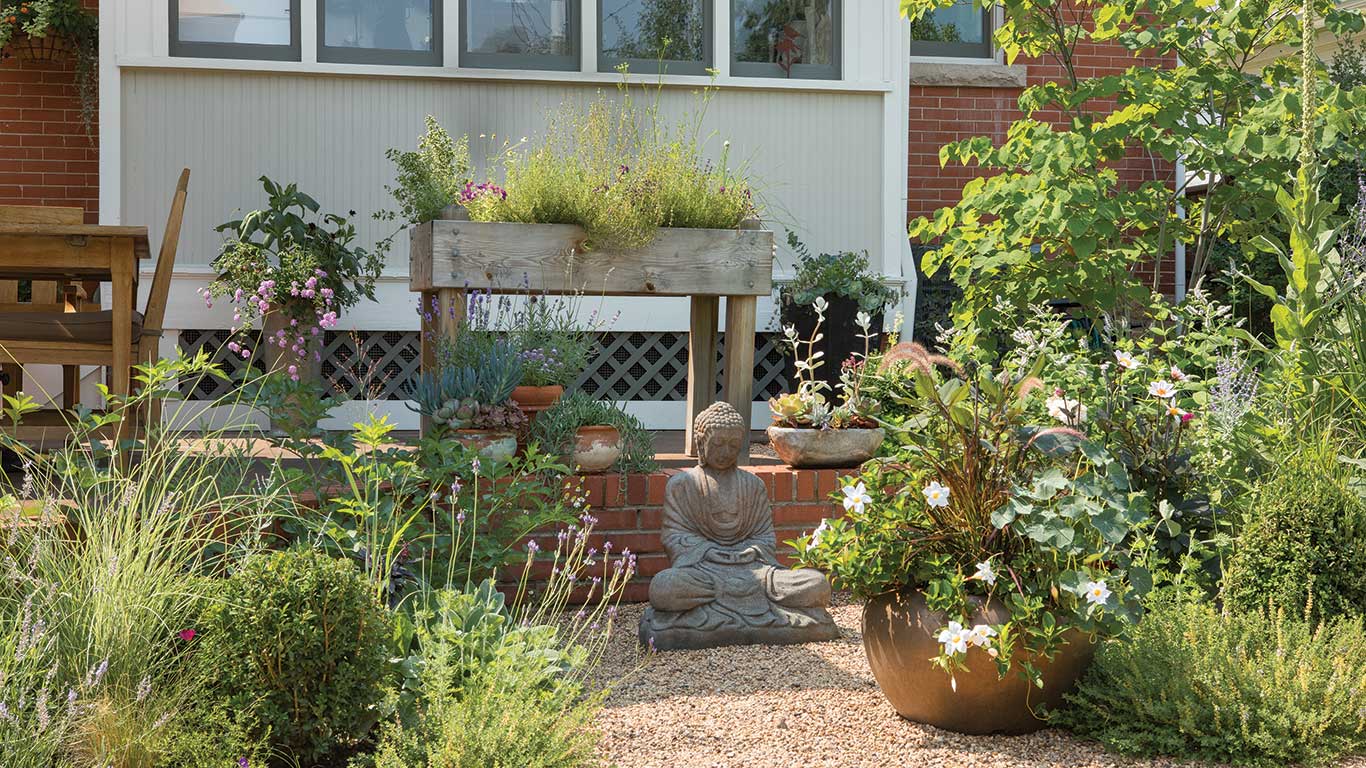Vertical Vegetables
02 Jul 2019
ARBORS
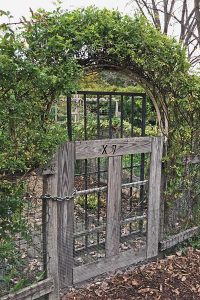 An arbor is a structure that is frequently found at the entrance of a garden or over the top of a pathway. It’s common for arbors to have latticework on the sides that is perfect for vining crops to grab on to.
An overhead arbor is often employed to create a gateway into a garden. This simple arch made from PVC and wire adds wonderful height over the top of the short gate. The thick vines also create a lovely privacy screen.
An arbor is a structure that is frequently found at the entrance of a garden or over the top of a pathway. It’s common for arbors to have latticework on the sides that is perfect for vining crops to grab on to.
An overhead arbor is often employed to create a gateway into a garden. This simple arch made from PVC and wire adds wonderful height over the top of the short gate. The thick vines also create a lovely privacy screen.
TRELLISES
 A trellis is probably the most well-known type of vertical gardening support, and trellises can come in many different shapes and sizes. But generally speaking, a trellis is a flat structure that can either be freestanding or attached to something else, such as a wall or fence.
Trellises can be freestanding or attached to something else, like this one that’s built onto the back of a large planter box.
A trellis is probably the most well-known type of vertical gardening support, and trellises can come in many different shapes and sizes. But generally speaking, a trellis is a flat structure that can either be freestanding or attached to something else, such as a wall or fence.
Trellises can be freestanding or attached to something else, like this one that’s built onto the back of a large planter box.
PERGOLAS
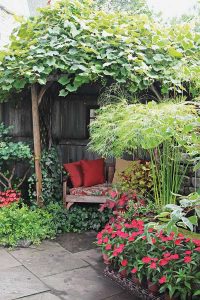 Larger than arbors, pergolas are permanent structures that are commonly used to shade a patio, deck, or garden area. Arbors and pergolas are similar structures, and often the only difference is their size.
Pergolas covered by vining crops such as these hardy grapes are fabulous for creating a private hideaway in your yard where you can relax after a busy day.
Larger than arbors, pergolas are permanent structures that are commonly used to shade a patio, deck, or garden area. Arbors and pergolas are similar structures, and often the only difference is their size.
Pergolas covered by vining crops such as these hardy grapes are fabulous for creating a private hideaway in your yard where you can relax after a busy day.
TEEPEES
 Teepees are fun structures that are easy to make. They can be as simple as a few twigs collected from the yard tied together at the top with twine, or as solid as this one, which is made out of sturdy 8-foot garden stakes.
A teepee is probably the simplest freestanding plant support you can make. Teepee structures are not only fun for growing vining crops like pole beans; they can also be used to create tunnels like this one or forts for children to play in.
Teepees are fun structures that are easy to make. They can be as simple as a few twigs collected from the yard tied together at the top with twine, or as solid as this one, which is made out of sturdy 8-foot garden stakes.
A teepee is probably the simplest freestanding plant support you can make. Teepee structures are not only fun for growing vining crops like pole beans; they can also be used to create tunnels like this one or forts for children to play in.
CAGES
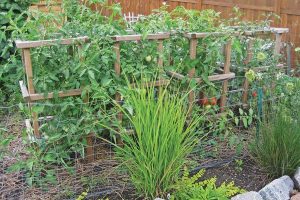 Cages are often circular or square, and they can range in complexity from flimsy wire tomato cages to heavy-duty wooden cages. They can be as simple as a circular piece of leftover garden fencing or chicken wire tied together at the ends.
Store-bought wire tomato cages work great for supporting determinate tomatoes, but indeterminate tomatoes need stronger structures, such as heavy-duty wooden cages, to support them.
Cages are often circular or square, and they can range in complexity from flimsy wire tomato cages to heavy-duty wooden cages. They can be as simple as a circular piece of leftover garden fencing or chicken wire tied together at the ends.
Store-bought wire tomato cages work great for supporting determinate tomatoes, but indeterminate tomatoes need stronger structures, such as heavy-duty wooden cages, to support them.
OBELISKS
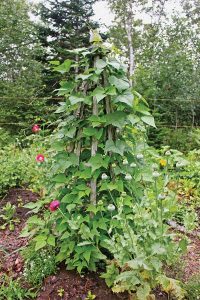 Obelisks are pyramid-shaped structures that have four sides and are traditionally found in formal gardens. They can be made out of any type of material, including wood, metal, or plastic, or even fashioned out of rustic materials like twigs and grapevines.
A garden obelisk has the geometric shape of famous architectural structures such as the Washington Monument. They have a formal appearance and can be a little trickier to build because of the angle-cutting, but they can make lovely focal points.
Obelisks are pyramid-shaped structures that have four sides and are traditionally found in formal gardens. They can be made out of any type of material, including wood, metal, or plastic, or even fashioned out of rustic materials like twigs and grapevines.
A garden obelisk has the geometric shape of famous architectural structures such as the Washington Monument. They have a formal appearance and can be a little trickier to build because of the angle-cutting, but they can make lovely focal points.
A-FRAMES AND LEAN-TOS
 A-frames and lean-tos are simple structures that can easily be made out of wood, twine, or metal garden fencing. They are almost identical, but an A-frame is shaped like an inverted V, whereas a lean-to leans to one side.
A-frames and lean-tos are perfect for growing crops like cucumbers, and they make harvesting easier. Tall A-frames like this one are not only great for growing vining crops; they also provide additional growing space for smaller crops, such as lettuce or spinach, under the frame.
A-frames and lean-tos are simple structures that can easily be made out of wood, twine, or metal garden fencing. They are almost identical, but an A-frame is shaped like an inverted V, whereas a lean-to leans to one side.
A-frames and lean-tos are perfect for growing crops like cucumbers, and they make harvesting easier. Tall A-frames like this one are not only great for growing vining crops; they also provide additional growing space for smaller crops, such as lettuce or spinach, under the frame.
TOWER GARDENS
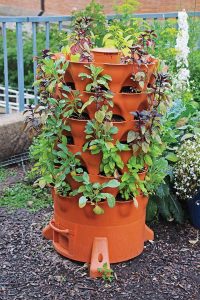 A tower garden is simply a tall or stacked container garden. A tower garden can be a tall structure that is made out of wood, metal fencing, or plastic, or even just a few stacked pots or planters.
Towers are simply stacked planting containers. You can buy stacked container growing systems that are specifically made for growing non-vining crops, such as herbs and salad greens, vertically. Systems like this one make it easy to get started quickly.
A tower garden is simply a tall or stacked container garden. A tower garden can be a tall structure that is made out of wood, metal fencing, or plastic, or even just a few stacked pots or planters.
Towers are simply stacked planting containers. You can buy stacked container growing systems that are specifically made for growing non-vining crops, such as herbs and salad greens, vertically. Systems like this one make it easy to get started quickly.
HANGING GARDENS
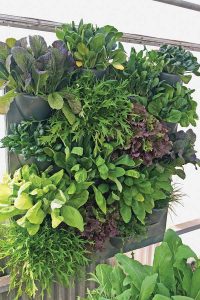 Hanging gardens can be anything from a few basic hanging baskets suspended from hooks, to more complex creations, such as vertical wall pockets, living walls and picture frames.
Hanging gardens, like living vertical walls, have become a very popular way to grow food. Small non-vining crops such as these salad greens thrive in vertical gardening containers.
Hanging gardens can be anything from a few basic hanging baskets suspended from hooks, to more complex creations, such as vertical wall pockets, living walls and picture frames.
Hanging gardens, like living vertical walls, have become a very popular way to grow food. Small non-vining crops such as these salad greens thrive in vertical gardening containers.
ARCHES
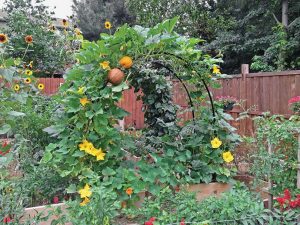 An arch in the garden can take the form of an arbor or a pergola, or it can be an architectural element on its own. Large arches are often used to create tunnels or shaded pathways, and small arches can be used in the vegetable garden to double your growing space by training heat-loving vines over the arch and planting cool-season crops underneath.
Arches can be constructed anywhere, and when built to a larger scale, they can be fun visual elements that draw attention to hanging garden fruits such as gourds, cucumbers, and melons. My squash arch is not only the focal point in my vegetable garden; it’s also functional and gorgeous. Growing squash vertically allows me to keep it under control so it won’t take over my small garden plot.
An arch in the garden can take the form of an arbor or a pergola, or it can be an architectural element on its own. Large arches are often used to create tunnels or shaded pathways, and small arches can be used in the vegetable garden to double your growing space by training heat-loving vines over the arch and planting cool-season crops underneath.
Arches can be constructed anywhere, and when built to a larger scale, they can be fun visual elements that draw attention to hanging garden fruits such as gourds, cucumbers, and melons. My squash arch is not only the focal point in my vegetable garden; it’s also functional and gorgeous. Growing squash vertically allows me to keep it under control so it won’t take over my small garden plot.
Amy Andrychowicz
 Amy Andrychowicz is the creator of “Get Busy Gardening,” a popular gardening website dedicated to beginner gardeners, where she has actively blogged for almost 10 years. She is the author of several eBooks available at GetBusyGardening.com. “Vertical Vegetables” is available from Cool Springs Press, an imprint of The Quarto Group.
Amy Andrychowicz is the creator of “Get Busy Gardening,” a popular gardening website dedicated to beginner gardeners, where she has actively blogged for almost 10 years. She is the author of several eBooks available at GetBusyGardening.com. “Vertical Vegetables” is available from Cool Springs Press, an imprint of The Quarto Group. 

